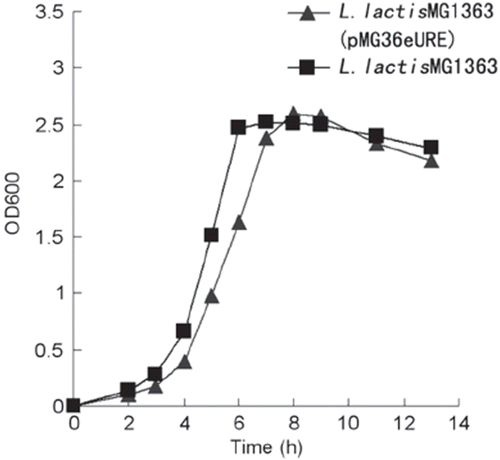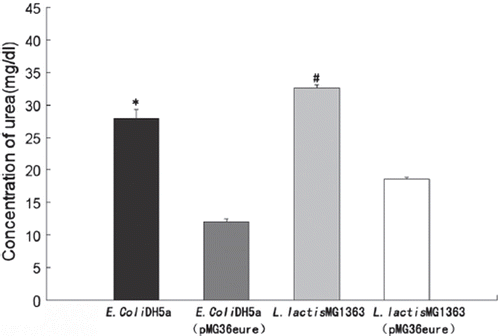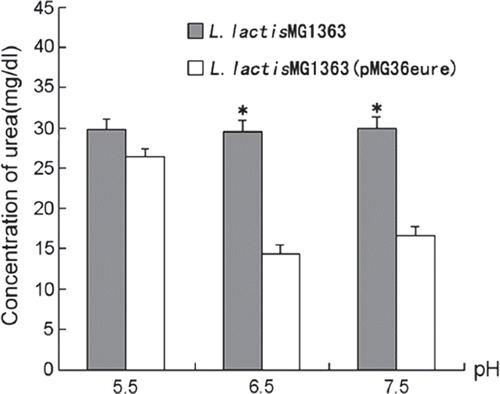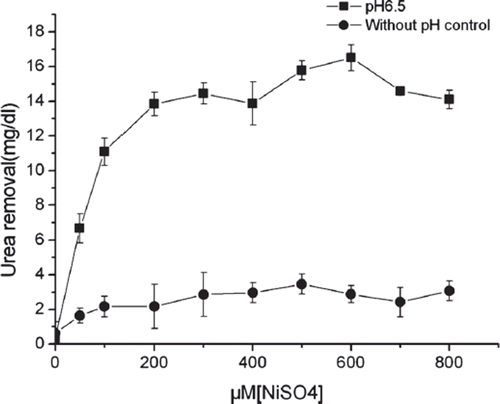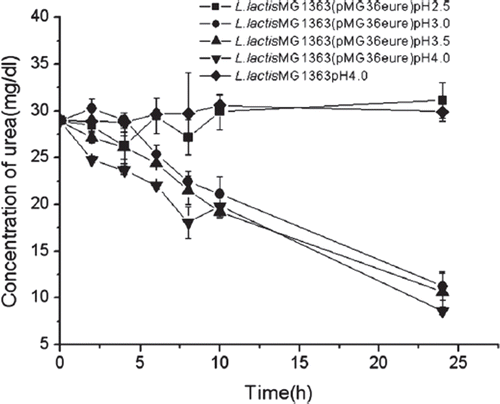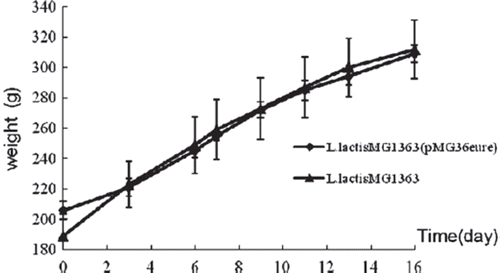Abstract
Kidney failure is a common disease with high frequency. Food-grade recombinant bacteria that can effectively remove urea has great potential for treatment of renal failure. A nonpathogenic strain, L. lactis MG1363, was transformed with plasmid pMG36eure, which carries urease gene. The expression of transgene urease in genetically modified L. lactis MG1363 and the urease activity in removal of urea were investigated. It was found that the removal of urea by recombinant L. lactis MG1363 was pH- and nickel-dependent. At pH 6.5 and in the presence of 250 μM of NiSO4, 50∼60% of urea could be removed in 24 hours. The urea removal activity was also evaluated in imitative gastroenteric environment. After being exposed to acidic solution (pH2.5-4.0) for 2 hours, the cells were then grown in a medium containing 0.1 cfu/ml bile acid salt, 30mg/dl urea, and 250μM NiSO4 at pH 6.8. The concentration of urea decreased over time, and the removal was about 30% at 10 hours and 65% at 24 hours, respectively. The safety tests were performed by feeding normal rats with either L. lactis MG1363 or recombinant L. lactis MG1363. The two materials did not cause any changes in blood cells and blood biochemical indexes. There were no differences in terms of body weight and water/food consumption between the two materials. These results indicate the safety, feasibility, and capacity of urease gene modified Lactococcus Lactis in removal of urea under the gastroenteric circumstances. Further investigation may generate a food-grade strain for treatment of chronic renal failure.
INTRODUCTION
Renal failure leads to accumulation of urea and other metabolic wastes, and causes high mortality rate. Dialysis (including hemodialysis and peritoneal dialysis) is one of the most effective ways to treat patients with chronic renal failure. But only 15% of patients in the world can afford the expensive treatment [Citation24]. The treatment is time-consuming and often causes many other risks.
An alternative way to dialysis therapy is oral administration of adsorbents or ion-exchange resins [Citation7]. Although it is cost-effective and convenient to patients, the efficiency of urea removal by these materials was too low to be useful for treatment. The current study in microbiology has developed many microorganisms that can effectively remove various metabolism wastes from the body. Previous study has shown that E. coli DH5 transformed with Klebsiella aerogenes urease gene can reduce urea levels in a rat model of renal failure. Encapsulation of the pathogenic strain E. coli DH5 made it available for oral administration [Citation18,Citation19]. However, the safety concern in using pathogenic E. coli as oral materials still remained. Therefore the study of food-grade recombinant bacteria that can effectively remove urea is of great importance.
Lactic acid bacteria (LAB) is a nonpathogenic strain, and it has been safely used for centuries in the food industry. It was first reported by Chow et al. [Citation4] that an LAB strain, Lactobalillus delbruechii, could be induced by repeated exposure in urea-rich medium to gain the ability to remove urea from plasma. Suspension of Lactobacillus in uremic plasma reduced the urea nitrogen levels from 51.5 ± 5.2 mg/dL to 44.3 ± 3.9 mg/dL after 24 hours. However, the limited fall in urea concentration might not be as effective as the genetically engineered E. coli DH5 [Citation18,Citation19] in order to achieve clinical benefit. Hence, to apply the genetic engineering approach in LAB may probably generate a safe and effective oral material to lower urea level in plasma.
Recombinant L. lactis has been developed for various industrial applications such as dairy products, fermented foods, probiotics, and live vaccines [Citation6]. Based on this progress, a large number of expression systems have been developed and used in the production of heterologous proteins [Citation16]. A nisin-controlled expression system (NICE) [Citation5] has been a successful and well-recognized system for heterologous protein expression in LAB.
Urease, which hydrolyzes urea into ammonia and carbon dioxide, plays an important role in nitrogen metabolism of plants and micro-organisms [Citation23] . A previous study has demonstrated that genetic modification of E. coli DH5 with urease gene could effectively reduce urea levels in a rat model of renal failure [Citation18]. In this study we used nonpathogenic L. lactis. We hypothesize that genetic modification of L. lactis with the heterogeneous urease gene will generate a food-grade recombi-nant bacteria that can be used for removal of urea from the patient, and has the potential for treatment of chronic renal failure.
MATERIALS AND METHODS
Bacterial Strains, Plasmids and Media
The BACTERIAL strains and plasmids used in this study are listed in . L. lactis subspMG1363, a gift from Dr. V. Pichereau (Université de Caen, France), was grown at 30°C in GM17 medium (M17 medium from Oxford was supplemented with 0.5% of glucose). Plasmid pMG36e was kindly provided by Dr. J. Kok (University of Groningen, The Netherlands). Plasmid pKAU17 (a kind gift from Dr. Mulrooney, Michigan State University, USA) expresses Klebsiella aerogenes urease gene. Shuttle vector pBluescript SK was from our college (Dr. Cao, College of Life Science, Nankai University). Escherichia coli (E. coli) DH5a was prepared in our lab and grown at 37°C in Luria broth (LB, Oxford). Restriction enzymes were purchased from TAKARA. For culture of E. coli, LB medium was supplemented with ampicillin (Amp, 100μg/ml). For L. lactis culture, GM17 medium was supplemented with erythromycin (Em,5μg/ml).
Table 1. Bacterial strains and plasmids used in this study
Construction of Plasmid pMG36eure
The 5.7kb fragment containing urease gene was digested with EcoRI and HindIII from plasmid pKAU17 [Citation14] and ligated into the shuttle vector pBluescript M13. Then the urease gene was cut with XbaI and EcoRI and cloned into vector pMG36e. The final plasmid was signified as pMG36eure.
Electroporation of L. lactis
Plasmid pMG36eure was transformed into L. lactis subsp-MG1363 by electroporation method using a Gene-Pulser apparatus (Bio-Rad) as described by Holo and Nes [Citation9]. The positive clones were identified on GM17 plate with erythromycin (5μg/ml) as a selective agent, and signified as recombinant L. lactis MG1363. E. coli was transformed with pMG36eure as previously described by Hanahan and Meselson [Citation8].
Transgene Expression (mRNA)
The transcription profiles of ure encoded on pM-G36eure was determined by reverse transcriptase PCR (RT-PCR) using the forward primer 5′ GAAACTCGT-GAACTGCGGGAGG 3′ and the reverse primer 5′GGCCGCTTTCCACGAAGATAAG 3′. Total RNA was isolated using the RNeasy kit (Sangon Company). DNA was eliminated from the RNA by treatment with RNase-free DNase I and RNeasy column. cDNA was synthesized and the PCR products were fractioned by electrophoresis on a 0.8% agarose gel stained with ethidium bromide and Imaged on a ImageMaster VDS (ImageMaster VDS, Pharmacia, Sweden).
Urease Expression (Protein)
The protein was extracted as previously described by Boucher et al. [Citation2]. The protein were diluted with loading buffer (40 mM Tris/HCl, 5 % mercaptoethanol, 1% SDS, 5 % glycerin, Bromphenol Blue, pH 6.8), and boiled for 5min before being loaded to 10% (wt/v) polyacrylam-ide SDS-PAGE gel. The separated protein bands were transferred onto a PVDE membrane, blocked with 5% skimmed milk in the TBS-T buffer (10mmol/L Tris HCl, pH8.0, 150mmol/L NaCl, 0.05, Tween20). Then the trans-blotted membrane was probed with anti-Klebsiella aerogenes urease antibodies anti-ureC and anti-ureE antibody (1:1000 dilution, gifted from Dr. Mulrooney), and followed by incubation with anti-rabbit IgG-alkaline phosphatase conjugates (1:10000 dilution). The nitrocellulose membrane was processed with enhanced chemiluminescence detection reagent (Santa Cruz Biotechnology, USA), and exposed to Kodak X-ray film.
Urea Removal
Recombinant L. lactis MG1363 was grown in GM17 medium containing 30mg/dl urea and 250μM NiSO4 for 24 hours. The pH was maintained at 6.5 by adding 1M NaOH solution. Recombinant E. Coli DH5a was grown at 37°C in LB medium containing 30mg/dl urea for 12 hours. The supernatant of both strains was centrifuged and was assayed for urea concentration by the Diacetyl Monoxime method [Citation25]. Diacetyl Monoxime reacts with urea and formed pink Generic Diazide derivative, which could be determined by spectrophotometer at OD540nm. The concentration of urea in samples was calculated using the standard curve.
The Effects of pH and Nickel Concentration on Urea Removal Activity
Recombinant L. lactis MG1363 was grown in a GM17 medium containing 30mg/dl urea and 250μM NiSO4 The pH was maintained at 5.5, 6.5, or 7.5, respectively, by adding 1M NaOH solution. The reduction of urea levels at different pH was investigated. To analyze the nickel-dependence of urease activity in recombinant L. lactis MG1363, cells were grown in GM17 medium containing 30mg/dl urea and varied concentration of NiSO4 ranging from 0 to 850μM. The concentration of urea was analyzed after 24h.
Urea Removal in Imitative Gastroenteric Environment
Recombinant L. lactis MG1363 was first grown in GM17 medium at varied pH from 2.5-4.0 at 30°C for 2 hours, and then the culture was centrifuged, resuspended in GM17 containing 0.1 cfu/ml bile acid salt, 30mg/dl urea, and 250μM NiSO4 at 30°C. The pH was maintained at 6.8. Every two hours, the supernatant was taken for urea concentration measurement.
Safety Test
Wistar rats were divided into 2 groups; each group had 5 animals. Group A were fed with normal strain, L. lactisMGl363, at a dosage of 2×109 cells/day each rat. Group B were fed with recombinant strain, L. lactisMGl 363 (pMG36eure), at the same dosage. During the 30-day experiment, animals were followed up for body weight, food/water consumption and blood biochemical indexes. At the end of the experiment, animals were killed and the weight of the organs was measured.
RESULTS
Characterization of Recombinant L. Lactis MG1363
The construct of pMG36eure was confirmed by restriction enzyme digestion (data not shown). DNA extracted from recombinant L. lactis MG1363 or recombinant E. coli DH5a were digested with XbaI and HindIII, two bands 5.7 kb and 3.6 kb were seen in the agarose gel (), which represent the urease gene and the pMG36e vector. This result indicates the successful transformation of L. lactis MG1363 and E. Coli DH5a with pMG36eure.
Figure 1. Identification of plasmid pMG36eure and expression of transgene urease in recombinant L. lactis MG1363. A: DNA extracted from recombinant L. lactis MG1363 (lane 1) or recombinant E. coli DH5a (lane 2) were digested with XbaI and HindIII. 5.7 kb and 3.6 kb represent the urease gene and the pMG36e vector. B: The transcript of urease gene was determined by RT-PCR with RNA isolated from recombinant L. lactis MG1363. C, D: Expression of transcriptional protein urease subunits UreE (C), and UreC (D) were analyzed by Western blot using cell extracts from recombinant L. lactis MG1363.
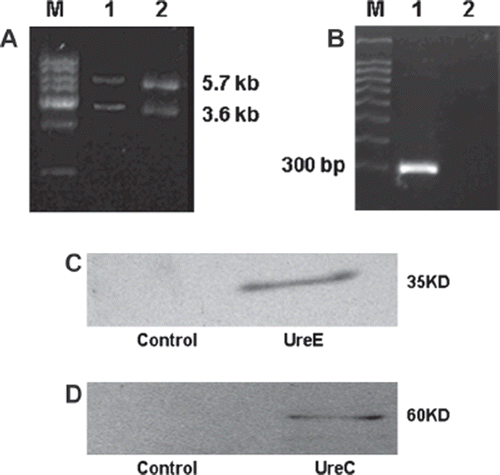
The expression of recombinant urease was examined by RT-PCR and Western blot. The transcripts of urease gene were determined by RT-PCR with RNA isolated from recombinant L. lactis MG1363. The 300bp fragment shown in Fig.1B confirmed the expression of urease in recombinant L. lactis MG1363. The expression of transcriptional protein was analyzed by a Western blot using cell extracts from recombinant L. lactis MG1363. The urease subunits UreE and UreC with the expected sizes were shown in , suggesting that the recombinant urease express in recombinant L. lactis MG1363. The growth curve as shown in indicates that urease gene modification did not influence the growth capacity of L. lactis MG1363.
Urea Removal by Recombinant L. lactis MG1363
Culture of urease gene modified E.Coli DH5a at 37°C, in LB medium containing 30mg/dl urea for 12 hours led to 57.1% removal of urea () However, the culture of urease gene modified L. lactis MG1363 in GM17 medium containing 30mg/dl urea for 12 hours did not show detectable reduction in the urea level (data not shown). In the presence of 250μM NiSO4 and at pH 6.5, which was maintained by adding 1M NaOH solution, 35∼40% of urea was removed by L. lactis MG1363 (pMG36eure) in 24 hours ().
Effect of pH on Urea Removal
The effect of pH on urea removal is shown in The concentration of urea was decreased by 50% after 24h with medium pH maintained at 6.5. The reduction of urea was similar in pH7.5 medium. However, culture of recombinant L. lactis MG1363 in pH5.5 medium did not show significant urea removal (<10%). As a control, the wild-type L. lactis MG1363 could not reduce the urea level because of the lack of a urease gene.
Effect of Nickel on Urea Removal
The dependence of urease activity on nickel was investigated. Without additional supplement of Ni2+, the urease activity was high in recombinant E. coli, and about 50∼60% of urea was hydrolyzed in 12 hours. However, no urease activity could be detected if recombinant L. lactis MG1363 was grown in GM17 medium without additional Ni2+ (data not shown). Supplement of additional NiSO4 to medium resulted in markedly enhanced urease activity in recombinant L. lactis MG1363 (Figs. 3-4). The removal of urea increased with NiSO4 concentration, which reached maximum at 200-300μM. However, the activation effect of Ni2+ required neutral pH. Without pH control, the enhancement of urease activity made by Ni2+ was limited ().
Urea Removal in Imitative Gastroenteric Environment
The urea removal activity of recombinant L. lactis MG1363 was evaluated in an imitative gastroenteric environment. shows that after an initial exposure of the strain to pH 3.0-4.0 medium for 2 hours, cells were grown at pH6.8 in a medium containing 0.1 cfu/ml bile acid salt, 30mg/dl urea, and 250μM NiSO4 at 30°C. The concentration of urea decreased over time, and the removal was about 30% at 10 hours and 65% at 24 hours, respectively (). The control L. lactis MG1363 did not show urea removal either.
Safety Test
Results show that there are no significant differences in body weight (), food/water consumption (), blood cells (), and weight of some organs () between the two groups. For the blood biochemical indexes (), differences were seen in some items between day 0 and day 30 in each group. However, the differences between groups A and B at the same time point are not significant. Despite the existence of these differences, all the values are within the normal ranges of healthy rats [Citation10,Citation22].
Table 2. Routine blood tests
Table 3. Organs weight (% of body weight)
DISCUSSION
Prakash and Chang have reported that E. coli DH5 transfected with Klebsiella aerogenes urease gene could reduce urea levels in a rat model of renal failure [Citation19]. In the present study, we applied a similar approach but using nonpathogenic, food-grade bacterium, L. lactis. It is the first attempt to develop a urease gene modified food-grade strain for oral administration to reduce the urea levels. This study generated a new recombinant strain, recombinant L. lactis MG1363, which expresses urease gene, and can effectively reduce the urea levels in the culture medium.
In contrast to the urease activity shown by recombinant E. coli DH5a (), the urease activity could not be detected if recombinant L. lactis MG1363 was grown in regular GM17 medium (data not shown). It was figured out that the urease activity in recombinant L. lactis MG1363 was pH- and nickel-dependent.
It is known that lactic acid bacterium produces lactic acid grown in glucose medium, and the accumulation of lactic acid leads to low pH [Citation21]. The effect of pH on the activity of Klebsiella aerogenes urease was shown as a nearly bell-shaped pH profile [Citation15]. Our result showed that 50% of urea could be removed in 24h when the pH was maintained at 6.5. However, the reduction of urea was less than 10% in pH5.5 medium (). The processes through which the pH affects the urease activity are unknown. Presumably, the pH external to the cells is transmitted through processes involved in maintaining the intracellular pH [Citation1]. The effect of pH on urease levels in vivo could be the result of changes in urease synthesis or degradation, or both [Citation20]. Or the possibilities would include incorporation of active binding site for nickel, which is another essential factor that influences urease activity. Interestingly, it was found in our study that when cells were grown with the same nickel concentration, the urease activity at neutral pH was 5-fold to that at acidic pH. It may suggest that external pH had an effect on nickel uptake and utility.
A previous study has demonstrated that the expression of urease was not nickel dependent; however, the urease activity was greatly affected by nickel concentration. This phenomenon can be explained by the fact that all purified ureases contain nickel. Klebsiella aerogenes urease contains two catalytic sites; each of them is associated with two Ni ions [Citation17]. For production of urease, Klebsiella aerogenes needs at least four other “accessory” genes, ureD, ureE, ureF, and ureG, which are thought to participate in the incorporation of nickel at the catalytic site [Citation12,Citation23]. However, the dependence on nickel is different in strains. Mulrooney [Citation14] reported that 100∼200μJ.m nickel was required for maximum urease activity in E. coli, which is similar to our result that recombinant L. lactis MG1363 showed maximum urea removal when nickel concentration was 200μm or higher (). In contrast, the highest level of urease in wild-type S. salivarius could be activated by as little as 2.5μm of NiCl2 [Citation3]. The urease expressed in B. subtilis conferred low levels of nickel-dependent activity to E. coli [Citation11]. In our experiment recombinant E. coli DH5a grown in LB without nickel reduced urea level from 28mg/dl to 12mg/dl after 12 hours (). It indicates the urease activity was not nickel dependent in E. coli DH5a. The mechanism is not clear. Perhaps the trace levels of Ni2+ contained in urease was sufficient for synthesis of active urease or that Ni2+ was not required.
The intestine is the major site for engineered bacteria to play a role in urea removal. For oral administration, stomach is another place that the bacteria have to go through. So the survival of recombinant L. lactis MG1363 and the urease activity in gastroenteric environment is the key of this study. The gastroenteric environment mainly refers to low pH of gastric fluid and high bile salt of intestinal fluid. Approximately, it is 1∼2 hours for food staying in gastric fluid (pH 1.5∼4.5) [Citation13]. Simulated gastrointestinal conditions were created in this study, and the urea removal activity was evaluated.
Table 4. Blood biochemical indexes
It was interesting to find that recombinant L. lactis MG1363 could reduce urea levels under simulated gastrointestinal conditions. As shown in , the urea levels decreased over time, and the reduction correlated to the pH to which the cells were exposed during the first 2 hours. It suggests that the cells survived in low pH are still functional when they were transferred to the simulated intestinal fluid which contains 0.1 cfu/ml sodium bile acid, 30mg/dl urea, and 250μM NiSO4 at pH 6.8.
Since the strain will be used as a function food, the safety test is important. Data showed that both L. lactis MG1363 and recombinant L. lactis MG1363 are safe. Feeding the animals with the two strains for 30 days did not cause significant changes in terms of body weight, water/food consumption and organ weight. The blood routine and biochemical indexes are within the normal range after 30 days.
The present study successfully developed a transgenic lactic acid bacterium. It can effectively reduce the urea levels under simulated gastrointestinal conditions. This is a progress on the basis of microencapsulation of genetically engineered E. coli DH5. The new approach is simpler and the products are safer. Further investigation will likely generate a product that may be effective in treatment of renal failure.
Declaration of interest: The authors report no conflicts of interest. The authors alone are responsible for the content and writing of the paper.
This paper was first published online as an Early Online article on 10 November 2009.
References
- Booth, I.R. (1985). Regulation of cytoplasmic pH in bacteria. Microbiol Rev. 49: 359-378.
- Boucher, I., Parrot, M., Gaudreau, H., Champagne, C.P., Vadeboncoeur, C., Moineau, S. (2002). Novel food-grade plasmid vector based on melibiose fermentation for the genetic engineering of Lactococcus lactis. Appl Environ Microbiol. 68: 6152-6161.
- Chen, Y.Y. and Burne, R.A. (2003). Identification and characterization of the nickel uptake system for urease biogenesis in Streptococcus salivarius. 57.I. J Bacteriol. 185: 6773-6779.
- Chow, K.M., Liu, Z.C., Prakash, S., Chang, T.M. (2003). Free and microencapsulated Lactobacillus and effects of metabolic induction on urea removal. Artif Cells Blood Substit Immobil Biotechnol. 31(4): 425-434.
- de Ruyter, P.G., Kuipers, O.P., de Vos, W.M. (1996). Controlled gene expression systems for Lactococcus lactis with the food-grade inducer nisin. Appl Environ Microbiol. 62: 3662-3667.
- De Vos, B., Vesikari, T., Linhares, A.C., Salinas, B., Pérez-Schael, I., Ruiz-Palacios, G.M., . (2004) A rotavirus vaccine for prophylaxis of infants against rota-virus gastroenteritis. Pediatr Infect Dis. J 23:S179-182.
- Friedman, E.A. (1996). Bowel as a kidney substitute in renal failure. Am J Kidney Dis. 28: 943-50.
- Hanahan, D., Meselson, M. (1983). Plasmid screening at high colony density. Methods Enzymol. 100: 333-342.
- Holo, H., Nes, I.F. (1989). High-frequency transformation, by electroporation, of Lactococcus lactis subsp. cremoris grown with glycine in osmotically stabilized media. Appl Environ Microbiol. 55: 3119-3123.
- Huang, X.Q., Kuang, S.S., Wang, G., Rao, Z.L., Lu, C.L., Liu, S.L. (2006). The influence of sex and age on the blood routine and biochemical indexes in Wister rats. Laboratory Animal and Comparative Madicine. 26(4):245-246 (Chinese).
- Kim, J.K., Mulrooney, S.B., Hausinger, R.P.. (2005). Biosynthesis of active Bacillus subtilis urease in the absence of known urease accessory proteins. J Bacteriol. 187: 7150-7154.
- Lee, M.H., Mulrooney, S.B., Renner, M.J., Markowicz, Y., Hausinger, R.P.. (1992). Klebsiella aerogenes urease gene cluster: sequence of ureD and demonstration that four accessory genes (ureD, ureE, ureF, and ureG) are involved in nickel metallocenter biosynthesis. J Bacteriol. 174: 4324-4330.
- Mao, Y., Doyle, M.P., Chen, J. (2006). Role of colanic acid exopolysaccharide in the survival of enterohaemorrhagic Escherichia coli O157:H7 in simulated gastrointestinal fluids. Lett Appl Microbiol. 42: 642-647.
- Mulrooney, S.B., Pankratz, H.S., Hausinger, R.P.. (1989). Regulation of gene expression and cellular localization of cloned Klebsiella aerogenes (K. pneumoniae) urease. J Gen Microbiol. 135: 1769-1776.
- Mulrooney, S., Zakharian, T., Schaller, R.A., Hausinger, R.P. (2001). Dual effects of ionic strength on Klebsiella aerogenes urease: pH-dependent activation and inhibition. Arch Biochem Biophys. 394: 280-282.
- Nouaille, S., Ribeiro, L.A., Miyoshi, A., Pontes, D., Le Loir, Y., Oliverira, S.C., . (2003). Heterologous protein production and delivery systems for Lactococcus lactis. Genet Mol Res. 2: 102-111.
- Pearson, M.A., Park, I.S., Schaller, R.A., Michel, L.O., Karplus, P.A., Hausinger, R.P. (2000). Kinetic and structural characterization of urease active site variants. Biochemistry. 39: 8575-8584.
- Prakash, S., Chang, T.M.. (1998). Growth and survival of renal failure rats that received oral microencapsulated genetically engineered E. coli DH5 cells for urea removal. Artif Cells Blood Substit Immobil Biotechnol. 26: 35-51.
- Prakash, S., Chang, T.M.S.. (1996). Microencapsulated genetically engineered live E. coli DH5 cells administered orally to maintain normal plasma urea level in uremic rats. Nat. Med. 2: 883-887.
- Sissons, C.H., Perinpanayagam, H.E., Hancock, E.M., Cutress, T.W.. (1990). pH Regulation of urease levels in Streptococcus salivarius. J Dent Res. 69:1131-1137.
- Sriwanthana, B., Island, M.D., Mobley, H.L.. (1993). Sequence of the Proteus mirabilis urease accessory gene ureG. Gene. 129:103-106.
- Tian, H., Fan, B.L., Liu, Y., Tian, J., Tang, X.Q., Gong, W.F. (2007). An approach to normal range of blood routine and biochemical indexes of SPF Wistar rats. Laboratory Animal Science. 24(2): 1-4 (Chinese).
- Todd, M.J., Hausinger, R.P. (1987). Purification and characterization of the nickel-containing multicomponent urease from Klebsiella aerogenes. J Biol Chem. 262: 5963-5967.
- Vanholder, R., Schepers, E., Meert, N., Lameire, N.. (2006). What is uremia? Retention versus oxidation. Blood Purif. 24: 33-38.
- Wang, J.G.. (1996). Clinical Biochemistry. 2nd ed. Chang Sha, China: Hu Nan Science and Technology Press.
